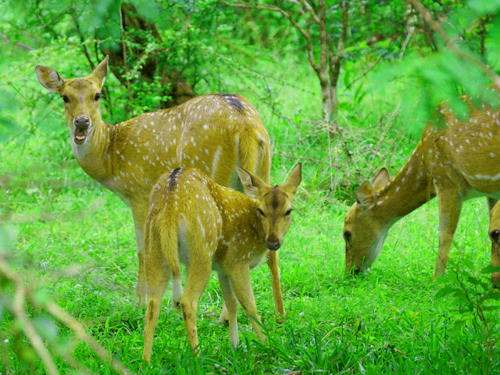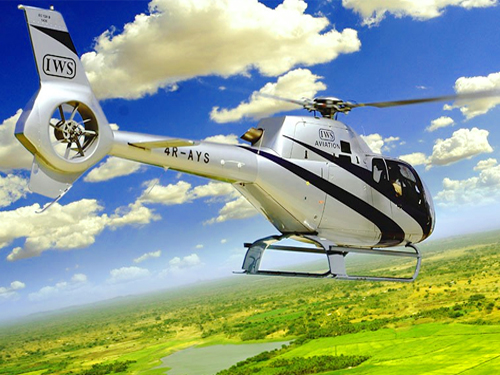Udawalawe in Sri Lanka
Udawalawe is located at the border of Sri Lanka's dry and wet zones. The topography is dominated by plains, but there are also mountainous areas. Annual rainfall in the park is 1,500 millimetres (59 inches) and most of it falls between October and January, March to May and March to April. The annual average temperature is between 27-28 degrees Celsius (81-82 degrees Fahrenheit), and the relative humidity ranges from 70% to 83%. Reddish-brown soil with good drainage is the dominant soil type. Valley bottoms have low-humic grey soils that are poorly drained. The beds of watercourses are mainly made up of alluvial soils.
Since its inception, Udawalawe National Park, which is located in Sri Lanka, has attracted thousands of tourists from all over the world. It has also contributed significantly to the development and growth of Sri Lanka's tourism sector for more than four decades. The high likelihood of seeing Sri Lankan elephants is the main reason why the National Park at Udawalawe has been regarded as a landmark. Every safari tour to Udawalawe will offer tourists the chance to see or get within a few metres of an elephant or several elephants. You can also see other exotic animals, like the Sri Lankan leopard or endemic birds at Udawalawe.
On the 30 th June 1972, Sri Lanka's fifth national park was established. The Udawalawe National Park was officially established as a national park and a wildlife sanctuary by the Fauna and Flora Protection ordinances of Sri Lanka.
Udawalawe National Park covers almost 31,000 hectares. This makes it one of the largest parks on the island. Udawalawe's most frequent environment is the dry grassland or scrubland. Udawalawe is home to large areas of tall grass, scrubs, and trees. These environments are where the elephants spend a large portion of their time. Although grasslands, scrublands and similar types are the most common habitats in the park's parks, it is not unusual to see mountainous or rocky areas.
The Udawalawe National Park's dry land area is approximately 119 miles, excluding the reservoir which covers 29,000 hectares. The boundaries of the Park include the Udawalawe Reservoir. It draws its water from the Peak Wilderness Sanctuary, the Horton Plains Reserve and the Haputale. This reservoir is a key area for the breeding of aquatic birds.
The Walawe Reservoir's deep waters are surrounded by beautiful open plains, foothills, and picturesque open spaces. To the north, the Kalthota Escarpment is the most prominent feature. The spectacular Diyawinne Falls are also to be found. Ulgala in the west is the highest peak. It rises to nearly 380m from the lowest point, which is 100 meters above the sea level.
The Park's climate is characterized by high temperatures and seasonal rainfall. Average annual rainfall in the Park is approximately 1,500mm at the south end and gradually increases towards north. There are two rainfall peaks in a year: one in April and May, and one between October and November. Between February and March, a brief dry spell occurs. From mid-May to the end of September, a longer dry period is observed.
Udawalawe is located towards the south of Sri Lanka, just like the Yala National Park. Udawalawe is a very different environment from the beautiful, scenic surroundings of the central region and the western region. Udawalawe's popularity has grown due to these different environmental conditions.
Even in the afternoon, you can see Sri Lankan elephants at Udawalawe. This park is known for its high likelihood of seeing the majestic creature in its natural habitat. Udawalawe can occasionally be seen with multiple elephants, or even a herd of elephants. Near rivers and the Udawalawe reservoir, there are good chances to see a herd or more of Sri Lankan elephants. Udawalawe is best visited during the dry season, which usually falls between May and September.
The journey from Colombo and other major cities in Western Province Sri Lanka is long, but not too tiring. The surrounding area of Udawalawe has many other tourist attractions and notable attractions. The Wavulpane Limestone Caves, hot wells, and the Elephant Transit Home all are located in the immediate vicinity of Udawalawe National Park. These factors add to Udawalawe's popularity as a top tourist destination in Sri Lanka.
Hopeacordifolia and Memecylonpeiolatum are the endemic species of floral plants found in Udawalawe National Park. Along with Terminaliaarjuna, Hopeacordifolia can be found alongside the river. The elephants need to eat Panicum maximum as well as ImperataCylindrica. The common taller trees are Berryacordifolia and Chloroxylon. Terminaliabellirica, Phyllanthusemblica and Phyllanthussylvestris are medicinal plants found in the forest. The grasslands are home to Cymbopogonconfertiflorus grass species as well as Grewiatrifolia bushes.
TerminaliaArjuna, also known as the " tree", is one of the many species of plants found in Udawalawe. This tree is also known as "kumbuk" (in Sri Lankan) and has been found along the rivers of the park. The tree is part of the Combretaceae family and can reach heights up to 70 feet. The tree's leaves are conical and oblong, while the colour is a mixture of green and brown. The bark is grey and the fruit grows towards the end. This tree can be found not only in Sri Lanka, but also in parts of India, such as south India. This tree is also known as "marudhamaram" in Tamil and "thellamaddi in Telugu.
Blady grass is also known as cogon grass and Japanese bloodgrass. It is one of the grass species that can be found at Udawalawe. This particular grass species is called "illuk" in Sri Lanka and is sometimes also known as kunai. This perennial grass is native to Australia and certain parts of Asia. Its scientific name is ImperataCylindrica. According to the Center for Aquatic and Invasive Plants of the US blady grass can be found in tropical and subtropical regions of the world at the moment.
The plant can grow up to 10 feet tall, and the leaves are only 2 cm in width. The plant is used by humans to build traditional houses and it is also a source of elephant food. Blady grass, which is highly flammable, is also considered a weed. According to the Invasive Species Expert Group (ISSG), Blady grass is one of the worst weeds in the planet. This is due to the fact that it can grow in many types of soil.
The ebony tree is a popular tree. It is known as the "Ceylon Ebony" tree because it can be found in Sri Lanka. The scientific name for the plant is Diospyrosbenum. It belongs to the family Ebenaceae. Both India and Sri Lanka have laws that prohibit international trade in this wood. This wood is also known as "kaluwara", in Sinhalese. It is widely used in the timber industry.
Although the height of an ebony tree is 100 feet, most ebony trees in Sri Lanka are shorter. Its wood is either black or grey-black, as its name implies. This species of plant produces a fruit that is approximately 2 cm in diameter. It is considered a type berry. In certain parts of Asia, the tree's parts are also used as medicine. BIOTIK, which provides information about biodiversity and taxonomy on Ceylon ebony, states that Ceylon ebony can be described as a canopy tree that is found in evergreen forests. These trees are easily visible at Udawalawe National Park along the riverbank.
The scientific name Panticum maximum has been given to Guinea grass, also known by the common name green panic grass. It is similar to Megathyrsusmaxus. This plant can be found in Udawalawe National Park, even though it is a native of Africa and parts of the Middle East. It was introduced to Udawalawe, Sri Lanka, and is considered an invasive weed on the island.
It can be found in open grasslands or near trees. The plant is very durable and can withstand even extreme drought. Elephants rely on Guinea grass for their food. Guinea grass, which can reach heights up to 3 metres and 10 feet, is a large perennial bunch grass.
One of the trees found in Udawalawe National Park is the Haldinacordifolia plant species. This tree is deciduous, meaning it sheds its leaves during certain seasons. This tree can be found in many parts of Sri Lanka and India. This tree can grow to 100 feet in height or more than 20 meters, but the majority of trees in Sri Lanka are not this tall.
UdawattaKele Sanctuary is located near Kandy and contains the HaldinaCordfolia tree. Botanists can identify the tree by its flowers because it is a flowering shrub. The flowering season usually runs from December through March, and June through August. This plant's leaves are bright green during some seasons, and yellow-brown in other seasons. The bark can be brown or grey-brown while the wood is yellow. These trees can be found on both plains and in foothills.
It is the only species in the genus Haldina and belongs to Rubiaceae. The plant Haldinacordifolia, also known as Haldina, is sometimes referred to simply as Haldina. Several sources also refer to this plant under the name Aldinacordifolia. This tree is also known in Hindi as "Kadam", and is used in India to make furniture.
Hopeacordifolia, a specific species of plant, is an endemic species in Sri Lanka. This particular tree's wood is a dark yellowish brown color and has many important attributes, such as its durability and hardness. Hopeacordifolia has been listed as endangered by the International Union for Conservation of Nature. Although the exact scientific classification of this tree is not yet confirmed, it belongs to Dipterocarpaceae. According to IUCN the tree was difficult to locate in many forest surveys in Sri Lanka. This tree was found along Udawalawe National Park's rivers.
This particular species belongs to the Lamiaceae family. It is native to South and South East Asia. The plant is also known in Sri Lanka as "milla", and is very popular in forests. These trees are also found in the Udawalawe National Park. This tree's scientific name is v Itexpinnata. It is also known as "laban" (Indonesia), "molave" (Philippines), and "tinnok” in Thailand. This tree is found in secondary forests and islands.
Milla has a slow growth rate, reaching 70 feet in height. The tree's bark is greyish brown, and the leaves are fragrant. Although the trunk can grow up to 10 feet in circumference, such large trees are uncommon in Sri Lanka. This tree's wood is very popular and is used in Sri Lanka. Milla is listed as an endangered species by the International Union for Conservation of Nature.
>This plant is an endemic species in the Udawalawe National Park. It belongs to the Oleaceae family. The Sinhalese name for this plant is "walpichcha", and the Kerala Forest Research Institute states that the plant's flowering season is between July to January. Wild jasmine's scientific name isJasminumangustifolium. This plant can be found both in an evergreen and a deciduous forest. This tree is easily found along streams banks, such as the Udawalawe National Park.
It is easy to see that this shrub is one of the smaller varieties. This plant can also be described as a small climbing bush or a scandent shrub. The plant's stem is smooth, and its leaves measure between 1 and 3 cm in length. The leaves are arranged in an opposite direction and take on a circular shape. The flower is used in Buddhist and Hindu temple offerings.
Wild jasmine can be found worldwide in Sri Lanka, India and Sri Lanka. Wild jasmine is the English name for the plant. The Tamil term is Kattumullai, while Banmallika is the Hindi term. This plant can be used in Ayurveda, traditional medicine. These medicines can be made from the roots and leaves, and may also treat stomach ailments.
Situated 165 km from Colombo, the entrance to the Park is near the 11th mile post on the Thimbolketiya/Thanamal- wila highway. The Park is rich in fauna and provides refuge for many species of animals that have been displaced or are endangered by the development projects. Udawalawe is home to many wildlife, including deer, elephants, wild boars, wild buffalo, wild boars, wild buffalo, snakes, reptiles and butterflies, as well as birds, such species include sambur, deer, wild boars, wild bison, wild buffalo, wild sambur, wild sambur, wild sambur, wild buck, wild buffalo, wild sambur, wild sambur, wild sambur.
Udawalawe is home of Sri Lankan wildlife, including the Rustyspotted Cat and Fishing Cat. Sri Lankan Sambar Deer is another species. Sri Lankan Axis Deer has Indian Muntjac and Sri Lankan Spotted Chevrotain. Wild Boar and Water Buffalo are other species. There have been reports of the presence of the Indian Hare and Toque Macaque as well as the Asian Palm Civets, Toque Macaque. Here are large numbers of Golden Palm Civets. Also, there are 5 species each of Indian Bush Rat and 3 Mongoose.
Ceylon spotted deer, also known as the Ceylon spotted deer, is one of Sri Lanka's most well-known animals. It is also known as the Sri Lanka Axis deer. Any wildlife enthusiast can identify the Ceylon spotted deer easily based on its physical characteristics.
It has white spots on its dark brown body. Ceylon spotted deer is a vital part of the fauna found in most wildlife sanctuaries and national park of Sri Lanka. They are found in lowland dry forests, shrub lands, and savannahs. The Ceylon spotted deer's favourite spot is also water bodies. Ceylon spotted deer are most active and visible in the morning and evening. These creatures can still be seen throughout the day. These creatures eat mainly grass, but they also eat leaves and fallen fruits.
These animals can be seen in herds at wildlife sanctuaries. There could be as many as 50 individuals. They are considered vulnerable due to the low number of Ceylon-spotted deer in Sri Lanka, and the rest of the world. Hunting and deforestation are the main threats to these peaceful creatures. The Ceylon spotted deer, a culturally significant species in Sri Lanka, is considered one of the most peaceful wild animals in the country.
The special place Sri Lankan elephants hold is unquestionable. They are often the center of attention in many fields, including tourism and cultural ceremonies. The majestic and grandiose festivals and ceremonies of Sri Lanka and the lush forests of Sri Lanka are just a few examples of elephants that seem to thrive unaffected.
The truth is much more complicated than that and all measures should be taken in order to preserve the elephant population. The ivory trade has had a long history in Sri Lanka, which has resulted in a devastating decline of the magnificent elephants of Sri Lanka. The ivory trade, which has spanned its influence for more than 2000 years, has mainly affected the elephant tuskers. This sad decline in the Sri Lankan elephant has been largely caused by poaching and hunting over the centuries. Human-elephant conflicts have increased due to the rapid development of Sri Lanka's settlements and projects.
The Sri Lankan leopard, which is an endemic species of Sri Lanka, is one of the most beloved animals. Its scientific name is PantheraPardusKotiya. The leopard is easily identifiable by almost everyone on the island. The leopard's body is dark yellow with black spots. These spots are dark yellow with black spots, while the leopard's underside is white. The leopard can grow up to 7 to 8 feet from its head to the tail, and can weigh in at 75 kilograms. The size of the female leopard is much smaller than that of the male leopard.
These magnificent animals can be found in the Udawalawe National Park, Wilpattu National Park and Yala National Parks. The Udawalawe National Park is home to the Sri Lankan leopard. The leopard is attracted to herbivores like deer and other small mammals. Two cubs are usually the litter of the Sri Lankan leopard. There is no distinct season for reproduction.
The leopard is a carnivore and eats all other species. The leopard is usually solitary, and in almost all instances it was seen at Udawalawe National Park there was only one. Sometimes, multiple leopards can be seen.
Culturally, Sri Lanka's leopard is one of the most well-known and beloved animals. This creature has fascinated local people for centuries, if not millennia. The leopard is Sri Lanka's top predator and only big cat. These factors have contributed to its enormous popularity.
IUCN has declared the Sri Lankan leopard vulnerable. The main reasons are habitat loss and human-lepard conflict. People living in the vicinity of leopard-rich forests attempt to kill it, as the leopard is a dangerous carnivore. The leopard is also at risk from poaching and hunting, as well as the increasing urbanization of Sri Lanka.
Researchers and wildlife experts from Sri Lanka have identified three types of grizzled giants. All three of these subspecies share the "Ratufamacroura" segment in their scientific names. These three subspecies of giant grizzled squirrels differ primarily in their primary colours. Ellerman 1961 also states that the classification of the grizzled giant squirrel was based on the variation of their colour. The creature is known in Sri Lanka as the Sri Lankan giant squirrel (English) and the Sinhalese "dadulena".
The primary colour of the grizzled giant squirrel is black. There are many variations of grey, brown, and even red. The grizzled giant squirrel's tail is white at the top. This is why they are called "grizzled". The environment and geographical location where they live will affect the colour of their bodies.These squirrels are easily identifiable by their long tails which allow them to balance well and their large hands which make it easy to climb. The grizzled giant squirrel also has large claws that can grip branches.
It is important to remember that giant squirrels are arboreal when considering their habitat. These tiny creatures are easily spotted by wildlife enthusiasts and other observers. These rodents thrive in woodlands and forests, which are rich in trees. The grizzled giant squirrel can be found in montane and tropical dry deciduous forests. These creatures have been identified only by observers in Sri Lanka and south India. While all the subspecies of tree are found in Sri Lanka, only one was found in southern India.
The grizzled giant squirrel, which is classified as a rodent, is highly territorial. It can climb and feeds on insects, birds, eggs, fruits and barks from certain trees.
The IUCN has given the grizzled giant squirrel a "Near Threatened” status. However, its popularity is not widespread. This species is most at risk from habitat loss and hunting.
A sloth bear's body length is generally between 140cm to 190cm. The male weighs between 80kg and 140kg, while the female weighs between 95kg and 55kg. The sloth bear's colour is black with brownish or greyish hairs. The sloth bear's snout is longer than other species, and is one of its distinctive physical characteristics.
This species is native to South Asia, including India, Sri Lanka and Bangladesh. The type of area where sloth bears can be found is tropical. In tropical areas, sloth bears love forests, scrublands, or rocky outcrops.
According to BBC Nature, the lifespan of the sloth bear has been accepted as being 25 years. Although reproduction of sloth bears is most common during the middle months, studies in Sri Lanka of sloth bears have shown that they mate all year. The details of mating are dependent on the source. The gestation or pregnancy period is usually between six and seven month. One to three sloth bear offspring are possible.
Sloth bears are omnivores and have a similar feeding pattern to other bears. The diet of the sloth bear includes fruits, flowers, insects, leaves and even leaves.
Although the sloth bear was once common in India and Sri Lanka, it is now rare (Ward and Kynaston 1995). IUCN considers the sloth bear a vulnerable species. Hunting is one reason. Traditional medicine uses parts of the sloth bear.
In Sri Lanka, the sloth bear is viewed as a single bear. Although the bear is well-known in Sri Lanka it is not often seen in its wild form. This is because the sloth bear, which can be dangerous for humans, lives in forests far from human settlements.
- Sri Lankan Spotted Chevrotain
- Thick-tailed Pangolin
- Toque Macaque
- Water Buffalo
- Wild Boar
A remarkable total of 183 bird species have been documented as living in the Park. Many others are passing through on their migration routes. Udawalawe is a wonderful place to go on a bird safari. Rare water birds such as Osprey and the Indian Cormorant can be seen at the reservoir. The Sri Lanka Spurfowl and Sri Lanka Junglefowl are notable endemic species.
>The Asian openbill, a wading bird found in Udawalawe National Park is greyish-white in colour. The Asian openbill has been known to travel long distances to seek food and to adjust to changes in the climate. They are large birds and can be found both in South Asia and in Southeast Asia. AnastomusOscitans is the scientific name of the Asian openbill.
Although the exact date of breeding for the Asian openbill depends on where it is located, it is usually between November and March in Sri Lanka. Droughts can stop breeding, and the Asian openbill typically lays between two and four eggs. Other birds share the trees where the Asian openbill makes their nest. This amazing bird can be seen at Udawalawe reservoir in Sri Lanka.
The black-capped Kingfisher is one of the most popular kingfishers in Sri Lanka. It has the colours black, orange-red and blue on its body. This bird is known as a tree-kingfisher, and is found in Southeast Asia and the tropical regions of Asia. It is also found in certain parts of Far East Asia. IUCN classified the black-capped Kingfisher as a species of least concern and gave it the scientific name Halcyon pileata.
One of the largest species of kingfishers, the black-capped kingfisher can be found in the Udawalawe National Park's woodlands and near waterbodies. This bird's length is almost 30 cm. It has a large bill that seems to be larger than its body. The black-capped Kingfisher eats amphibians and both fish and insects fall prey to it.
The black-capped Kingfisher is one of the most popular kingfishers in Sri Lanka. It has the colours black, orange-red and blue on its body. This bird is known as a tree-kingfisher, and is found in Southeast Asia and the tropical regions of Asia. It is also found in certain parts of Far East Asia. IUCN classified the black-capped Kingfisher as a species of least concern and gave it the scientific name Halcyon pileata.
One of the largest species of kingfisher, the black-capped kingfisher can be found in the Udawalawe National Park's woodlands and near waterbodies. This bird's length is almost 30 cm. Its bill seems large compared to its body. The black-capped Kingfisher eats amphibians and both fish and insects fall prey to it.
The ICUN has listed the booted eagle "least concern" as it is found in the Udawalawe National Park. Bird watchers are proud to spot this magnificent bird. It is also a top predator among the birds in Udawalawe. The body of the booted Eagle is brown, while the belly is either white or light brown. The colour of the beak is black and yellow for the booted Eagle.
The booted eagle's scientific name is Aquila pennata. It measures nearly 50 cm in length. It is a medium-sized eagle with a wingspan of 120 cm.
The female booted Eagle lays one to two eggs and then deposits them in nests or trees. The booted Eagle can also be found in Asia, North Africa, and southern Europe. The male weighs between 600 to 800 grams and the female weighs between 800 and 1,1000g.
The changeable hawk eagle, which is listed as a "least-threatening" species, is also known by its distinctive crest as the crested Hawk-Eagle. The reddish-brown or brown body of the changeable Hawk-Eagle can be found both in South Asia and in Southeast Asia. Many bird lovers love to spot this type of eagle in Sri Lanka's Udawalawe National Park.
The changeable hawk-eagle prefers open woodlands over water bodies and is known to live a lonely life. It is a large bird with a wingspan between 125 to 140 cm. The call of this bird is also a way to identify it. Its wings are kept flat when in flight. Small mammals, birds and reptiles are all eaten by the changeable hawkeagle. This bird's scientific name is NisaetusCirrhatus.
- Brown-capped Babbler
- Crested Serpent Eagle
- Eurasian Spoonbill
- Grey-headed Fish Eagle
- Indian Roller
- Malabar Pied Hornbill
- Painted Stork
- Peafowl
- Pied Cuckoo
- Red-faced Malkoha
- Spot-billed Pelican
- Sri Lanka Grey Hornbill
- Sri Lanka Junglefowl
- Sri Lanka Spurfowl
- White Wagtail
- White-bellied Sea Eagle
Reptiles in Udawalawe National Park
Bengal Monitor
The Bengal monitor is similar to the water monitor and is sometimes called the common Indian monitor. This monitor lizard is found in Udawalawe National Park. Its colour ranges from brown to gray and can weigh up to 7 kg. They are smaller than their male counterparts, and they measure between two and four feet in length.
The Bengal monitor is found in forests as well as other habitats, such as deserts. These creatures can be seen in the wild at Udawalawe National Park. This monitor lizard is a frequent visitor to the Udawalawe National Park's tropical forests, scrublands, or grasslands.
Female Bengal monitors can lay eggs, and there could be more than 20 offspring. The gestation or pregnancy period can range from four to eight weeks. It is classified semi-aquatic and feeds almost all small animals, including birds, fish, lizards and snakes. The International Union for Conservation of Nature has designated the water monitor "least concern". This creature can be easily identified throughout Sri Lanka.
Mugger Crocodile
There are a few species in Sri Lanka that live in crocodiles. The mugger crocodile is one of them. It can be seen at Udawalawe National Park, as well as other parts of the island. These creatures will captivate visitors to the park, as they can be seen within a few metres at the Udawalawe Reservoir. It is scientifically known as Crocodyluspalustris and is sometimes called the "crocodile in the marsh".One of its most distinctive features is the mugger crocodile's broad nose. This makes it look similar to alligators. The length of males can reach over 12 feet and 4 meters, while the size of females is smaller than that of their male counterparts. These species are considered medium-sized crocodiles because they have a variety of colours, from dark brown to light brown.
South Asia is home to mugger crocodiles, which can be found in Sri Lanka, India and Pakistan. Udawalawe National Park in Sri Lanka is a great place to see this incredible reptile. These creatures can be seen at the Udawalawe reservoir and other nearby water bodies. These creatures are found in freshwater bodies, as well as rivers, swamps, and marshes.
According to the International Union for Conservation of Nature (IUCN), the mugger Crocodile is listed as endangered and sub-classified in vulnerable. It is the most widely used crocodile species of South Asia.
Oriented Lizard
There are many reptiles in the Udawalawe National Park. The most well-known is the Oriental garden Lizard. Calotesversicolor is the scientific name for this reptile. This lizard's colours change greatly and can reach a length of more than 35 cm from head to tail. One of the most distinctive features of this species is its crest.
The Oriental garden lizard can be found on the continent of Asia. They are not endangered because of their adaptability. A total of 20 eggs can be laid at once in moist soil. These eggs hatch after six to seven weeks. During breeding, the male Lizard becomes very territorial.
The Oriental garden lizard is a prey for small insects, small vertebrates, and other small creatures. These creatures swallow whole the prey. The ability to change the colour of its body makes the Oriental garden Lizard a culturally important lizard. It is found in areas that are home to human communities and seems to be protected from a few threats.
Sri Lankan Pipe Snake
The country is home to many snake species, including the Sri Lankan piper snake. These snakes have both conical tails and hind limb vestiges. Additionally, their heads are wedge-shaped .Cylindrophismaculata is the scientific name for the Sri Lankan pipe serpent.
These snakes belong to the Cylindrophiidae family, but it is believed that they were originally assigned to the Aniliidae or Uropeltidae families. The Sri Lankan pipe serpent is also called the Ceylonese Cylinder snake and is sometimes. It is commonly known simply as the pipe snake. Although the pipe snake can be found in most of the country's regions, the precise territories have yet to be confirmed.
Sri Lankan Viper
The Vipers of Sri Lanka could refer to two highly venomous species, the general viper, and five moderately venomous pit vipers.
All the vipers in Sri Lanka are large-headed and some species have an organ called the loreal. This organ is located between the nostrils of vipers and their eyes. The ability to sense heat allows vipers to identify their prey.
These vipers have different habitats and can live in both the dry and wet zones of Sri Lanka. Vipers are also found in national parks and forests. There are slight to moderate differences in the physical characteristics of vipers living in different parts of the country.
Sri Lanka's endemic green pit viper snake is the green pit viper. Vipers are adaptable and can withstand a variety of threats.
Water Monitor
Water monitors can be found along the rivers of Udawalawe National Park. These creatures are closely related to the Komodo Dragon. These creatures average between 20-30 kilograms in weight and can reach up to two meters in length. It is second in size to the Komodo dragon.
There are many habitats for the water monitor, and visitors can see it along the Udawalawe National Park's riverbanks. The eggs are produced, and they are often deposited alongside rotting logs near water bodies. The mating season usually falls between April and October. The Max Planck Institute estimates that the water monitor's average lifespan is 10 years.
It is classified as semi-aquatic and feeds almost all small animals, including fish, lizards, snakes and birds. It is easy to recognize in Sri Lanka, as the International Union for Conservation of Nature has designated it "least concern".
Udawalawe Elephant Transit Home
Udawalawe Elephant transits home (ETH), also known udawalawe elk orphanage. The Elephant Transit Home's main purpose is to rehabilitate or release infant elephants into the wild. In 1995, the Ministry of Wildlife Conservation was instrumental in protecting and caring for orphaned elephants. “AthAthuruSevana” was established at Udawalawe National Park.
Elephant Transit Home, also known as Elephant Home for Orphans (ETH), takes care of orphaned elephant calves and allows them to become independent enough to be released into nature. Although the overwhelming support of the general public was enthusiastic, conservationists initially doubted its viability.
How to go Udawalawe National Park
The Udawalawe National Park lies approximately 160km to the South East from Colombo. It covers an area of 31,000 hectares. This Park lies within the Ratnapura and Moneragala Districts and can be reached from Colombo via Ratnapura, Pelmadulla and Colombage-ara junction along the Pelmadulla-Embilipitiya road. It takes approximately 3-4 hours to travel. You can also reach the Park by air travel. You can charter a helicopter from either the Bandaranaike Airport, or Ratmalana to land at the Udawalawe Police Grounds. You can then drive to the Park from there. This area does not have an Air Taxi Service.
Best time to go Udawalawe National Park
Udawalawe's elephants can be viewed all year, but migrants’ birds are only allowed to be seen between November and March. When elephants are in large numbers, the dry season is the best time to visit Udawalawe.

 Safe Travels
Safe Travels Français
Français Deutsch
Deutsch עִברִית
עִברִית Italiano
Italiano Nederlands
Nederlands Polski
Polski Pусский
Pусский Español
Español














































